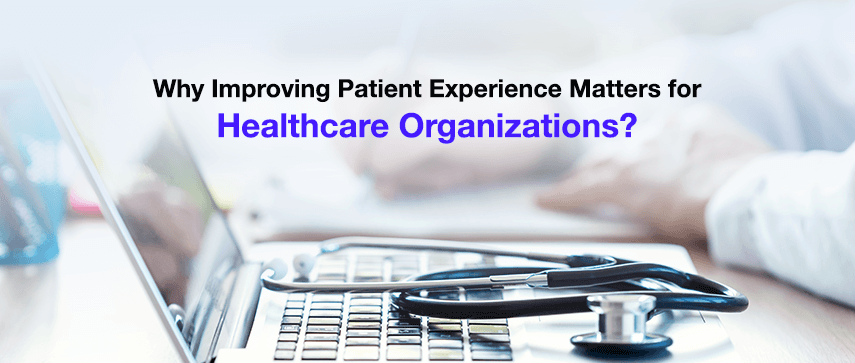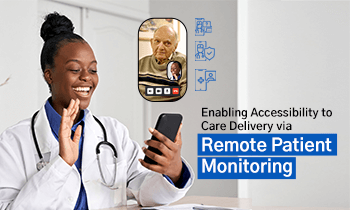The healthcare industry is becoming dynamic due to medical progress and advancement in technology. Rising demand and an aging population are ushering in significant changes. Improving patient experience, along with engagement, has become paramount. Hospitals create a more substantial impact by delivering personalized and convenient services. They ensure a feel-good atmosphere and bring mental peace to all the stakeholders.

Transformed Patient Experience
The advancement in technology and competition in the market highlights the importance of customer experience. Applying this concept to healthcare, a service provider brings forth the value of patient experience. Particularly after the Covid-19 pandemic, transformative engagement has become vital. Hospitals and clinics streamlined their interactions for improving patient experience.
While other industries focused more on customer experience to stand distinctive in the market, the healthcare industry was long focused on just better health outcomes, diagnostics, and operational standards. But after the pandemic, there has been a marked shift in delivering superior patient care experience. The paradigmatic shift focuses on patients’ concerns, expectations, perceptions, and safety. Let’s have a look at what has evolved in healthcare due to this pandemic.
1 Pre-care
65% of the customer indicates that their experience on the hospital website for scheduling the appointment, gaining information, and others are equal to the actual treatment. 80% of surveyed patients use online reviews as a significant deciding factor. Around 50% of the patients in a study assured that they are ready to change their insurance provider to choose a healthcare provider with better reviews.
2 Speed
The patients expect better experience, convenience, and a sense of accountability along with a closed-loop real-time approach. They want healthcare providers to offer quick service. Patients also expect service providers to use patient engagement technology to create a transformative effect. Automated tools like customer relationship management (CRM) and Electronic Health Records (EHR) build transparency, speed, and convenience. They also enhance communication and quality of patient feedback. For example, using deep learning and AI, a healthcare provider can analyze a CAT scan faster than humans by 150 times.
3 Shift to Virtual Care
Do you know that the new Apple Watch has biosensors to detect changes in health? The coronavirus caused a 70% cancellation of treatments due to fear of contracting the virus or other restrictions due to lockdown. According to an Accenture survey on 2700 patients, the results favor virtual care. 60% of the surveyed patients are planning to have treatment from home. Thus, if a healthcare provider cannot offer virtual care, there is a possibility of losing 60% of their customer base.
4 Personalized Response
47% of the participants of the Accenture study expect a personalized response. Almost half of them also want faster service. Since COVID-19 pushed several services, including transportation, into stagnation, people prefer all these from their home’s comforts. The only way for a healthcare service provider to offer such a service is by automation and machine learning. The use of technology could be as small as video conferencing for a consultation to remote monitoring tools with software interfaces.
So how to choose the right method that would suit a particular healthcare provider? A small clinic cannot rebrand itself to suit every trend in the market. Choosing the right method is not guesswork, but the result of extensive analysis. One of the best patient satisfaction measures is the consumer assessment of healthcare providers and systems (CAHPS). These surveys measure various factors like nursing, doctor expertise, and hospital environment. They also factor in pain management and care experience continuity.
All these trends indicate that patients expect superior services. They desire comprehensive care with 360-degree care and positive outcomes. And the healthcare industry is rising to the occasion by relying on technological and scientific solutions.
Driving Forces of Such Transformation

The shift from simple engagement to a profound experience is vital. The transformative effects are very explicit in both patients and the clinical staff. The employees realized the importance of patient experience in healthcare. They don’t limit themselves to clinical outcomes alone.
Yes, patient engagement is not something new, but prioritizing the experiences was never a forceful trend like now. Its transformative effect is attracting most healthcare organizations today. And these professionals strive to deliver exceptional patient experiences through effective care.
Let us look at a few factors that play a significant role in this transformation. These clinical and business forces are the reason behind a paradigm shift. Knowledge of these driving forces is also essential to strategize innovative caregiving solutions.
Market Demand
The patients’ expectations and perceptions of “hospital experience” are not the same as a few years ago. The tech-savvy generation has easy access to Wi-Fi and mobile devices. They are well aware of hospital services and know more about diseases, diagnoses, and treatments.
So, they are not merely looking for clinical outcomes alone. They expect impactful engagements with the nurses and physicians. They also demand exceptional experiences for both out-patient and in-patient services. A customer can compare a healthcare service for a specific disease between two or more hospitals before even stepping into one. Thus, the only way to stay afloat is by offering the best diagnosis, treatment, care, and better experience for the patient.
Digital Awareness
The tech-savvy market changed various industries and their operational processes. These industries enhance customer and user experience through digital engagement. The spread of digital media usage is not specific to some industries like banking, marketing, retail, and others.
Patients in hospitals also expect digital assistance from hospitals or clinics now. Considering the tech-savvy generation, their demands, and dependence on digital tools, they even choose hospitals based on their digital capabilities – technological support and mobile-friendliness. So, healthcare providers have no other option but to comply or become obsolete. They have to plan, budget, and implement the necessary transformations in a short time. To stay competitive, they have to deliver up-to-date services. Healthcare activities have to get accelerated to satisfy new-age customers. Those who fall back will risk losing their business reputation as well as customer loyalty.
Competition
The Healthcare sector has revised service configurations; their focus has now shifted to providing customer-centric, qualitative services. Technology plays a crucial role in case hospitals or clinics want to outsmart the competition and offer cost-effective services. So it will be beneficial for them to invest in digital platforms to survive in such a competitive market.
Furthermore, the markets are growing fast, and only organized services can guarantee enhanced experiences. The technology investments also act as a catalyst for them to deliver transformative effects. They can also scale up operations with ease.
Ease of Operation
Patient experience is not just for attracting patients or for better reviews of hospitals. Every effort that a healthcare provider offers to improve the patient experience would simplify the process for the staff. Most hospitals today have patient portals for easy digital access. So the patients can schedule appointments or pay the bills online without any hassles. They can also communicate with the care teams for personalized assistance in treatments remotely. Thus, a healthcare provider can offer high-level service without increasing the resource requirements and other costs.
Moreover, the demand for telemedicine because of the current pandemic is a major driving factor. Machine learning and AI technologies now help deliver effective, timely, and customized care for more-demanding patients.
Profit
Patient engagement technology improves the patient’s experience strategically with great initiatives. If a service provider can improve patient experience, the growth in the business will be paramount. According to a study on US hospitals, the service providers who offer superior customer experience had 50% more net gain margin than service providers who offer average experience.
So, above are the internal and external factors driving the new interest in increasing patient experience. But, how is it possible to improve the experience of someone coming to a hospital in distress? Let us see in detail the strategies that major players use to enhance their customer experience.

Patient-Centric Strategies: What Healthcare Organizations Do to Enhance the Patient Experience and Drive Quality Care?
Healthcare organizations can implement various strategies to achieve two primary goals – improving patient experience and clinical outcomes. No patient wants to experience inadequate treatment in the hospital. He expects the hospital to provide enough medical treatment.
Also, the patients want the best medicines from pharmacies, with better exposure to information and options. Medical establishments can satisfy these demands through manual or digital strategies. Or they can find a balance between these two principle resources.
Manual operations include cultural transformation and effective leadership. Hospitals can also focus on integrity, transparency, accountability, and impeccable execution. But they have to plan all these activities and implement them with the help of employees.
The human touch is necessary as it makes the patients feel safe and secure. But modernized, digital solutions are also a viable proposition. Technologies like AI, machine learning, chatbots, and digitized patient records are valuable in speeding up services without a drop in quality of care. Other strategies are as mentioned below:
i Merger with tech giants
Patient engagement solutions are data-intensive. Accessing health records and clinician notes via online portals or cloud makes treatment easier and faster. The data’s visibility adds transparency to the process, which helps improve the quality of treatment and ethical procedures. It helps build a patient-doctor relationship, which is vital for the growth of the clinic. Such a solution is possible with a merger with digital solution providers or digital product development companies like Mobisoft Infotech.
ii Shift to consumerism (treat patients like consumers)
There is no doubt that the overall cost of healthcare per individual is increasing. Thus, patients, especially ones with long term illness, prefer to choose cost-effective options. Thus, healthcare providers should focus on selecting technologies that would reduce resource requirements and other overhead costs. 10-22% of the population in a survey avoided medical help because of cost, and 19-35% delayed the required procedure for the same reason.
Physicians and their teams focus only on diagnosing the condition swiftly and accurately and offering immediate or continual treatment. This strategy of consumerism adds dignity, empathy, and respect to this process. Practitioners cannot treat patients like test subjects. Considering the patient’s preferences to provide healthcare services can be a good patient-engagement strategy. For example, a simple checklist of procedures generated based on the patient’s demands can improve satisfaction.
iii AI-powered solutions for better employee satisfaction
AI-enabled patient-engagement strategies are indeed very powerful. The solutions are possible to execute by integrating voice-enabled tools or chatbots or other omnichannel plans. Even patient interactions can get accurately analyzed to derive high-quality intelligence. Also, personalized patient experiences can become possible.
Machine learning techniques also allow improving employees’ productivity, which leads to increased satisfaction. According to the Healthcare Satisfaction Report of Press Ganey, an increase in employees’ satisfaction can increase patients’ quality care. The best example is the chatbot, which saves employees time and energy in optimizing patient engagement. They help patients with reports, billing, drug prescriptions, and personalized conversations.
iv Healthcare and clinical quality
Medical care gets bogged down by the silo mentality of the staff. Poor execution of plans can even drive away the patients towards competitors. The solution lies in relying on digital transparency and data-intensive operations. Patients expect lower readmission rates for the same ailment, reduction in after-care solutions that restrict routine, decreased length of hospital stay, and more. All these translate as better, faster, and more accurate treatment. Non-invasive and less pain enduring treatments are also some of the new strategies.
Analytical data is a veritable goldmine for the healthcare provider. It helps with administration, planning business strategies, marketing, and enhancing patient experiences. The entire patient feedback loop is the starting point to generate accurate reports. It is paramount to implement the right strategy within the right time and for the right purpose.

The healthcare market is dynamic, competitive, and tech-savvy. But the customer is the king in every type of business, including healthcare. So, improving patient experience gained recognition and acceptance in recent times. Also, patients and their families have become very conservative about their spending.
Consequently, the healthcare industry’s future depends on optimized services. No hospital or clinic can ignore or neglect their patients anymore. They have to promise and deliver high-quality care at affordable rates. Otherwise, the finicky customers will shift their loyalties to a market competitor.
The various interactions across the care spectrum influence patients’ perceptions. Empowered customers with digital access demand better healthcare. They aspire for superior medical services with positive outcomes. Culture, location, language, and personal choices are great influencers.
Why should a healthcare provider spend resources on improving patient experience along with conventional demands like better healthcare, low cost, and more? Let us understand.
Better patient engagement
Both patient and family engagement in the treatment process improves the efficiency of the procedure. Their support is essential to identify diseases at the onset proactively. The treatment procedures also become less complex or expensive due to such engagement.
Reaching out to patients and providing a better experience for your patients will build confidence and facilitate communication. A comfortable and safe environment with ready access to vital information can reduce confusion and anxiety in a hospital. Customer-friendly remote digital tools are efficient only when you promote better patient engagement.
Outcome Optimization
Patient care experience is a mirror to the quality of your healthcare process. A supportive care system will implement timely procedures to match up to patients’ expectations. The healthcare provider uses AI or other tools to reduce the waiting time and improve tests’ accuracy to show empathy and build trust.
A colorful and quiet ambiance also soothes many patients. Patient-friendly medical tools like diagnostic tools, also build confidence. With such positive experiences, reputation increases. And the whole caregiving setup becomes an excellent asset for the hospital. Why is your hospital’s reputation essential? Because a healthcare provider’s reputation is one of the primary factors in selecting a hospital.
Cultivating Loyalty
Marketing extraordinary services are not sufficient in current times. The hospital has to deliver professional care with excellence. The caregivers have to be affable, generous, and easily accessible.
The healthcare provider has to promote medical literacy. Their treatment should be in tune with patients’ preferences. They have to minimize discomfort and maximize safety considerations. Patients shift brand if the competitor offers better patient engagement and experience. The bottom line is, do you want your competitors to steal your customers?
Tips to Improve Patient Experience
Patient experience in healthcare is intrinsically tied with technology. The patient management system has to assure value-based services. Satisfying the patients is also vital for optimizing the healthcare system itself. It also reduces hospital costs and ensures the overall health of society.
Clinical outcomes and patient satisfaction are equally relevant. Research proves that balance is essential between these two approaches. Hospital ambiance, responsive staff, pain management, communication, etc., are vital for achieving satisfactory results.
Prioritizing care and patient engagement are essential. So too are new delivery models, care metrics, and data analyses. And inconsistencies elimination through tools, motivation, incentives, and quality care would add more quality. The following tips are also effective in improving the patient experience:
1 Patient satisfaction is a balancing metric
Ensuring satisfaction through positive patient experience is not a guaranteed science. The hospital also has to treat the experience metric as a balance factor.
As a balancing measure, it is useful in improving care quality. The staff should deliver services without losing sight of the outcomes. If a patient wants to get discharged early, then the length of stay has to be short. Making length of stay (LOS) longer will create an unpleasant experience for the customers. But, a potentially infectious or high-risk patient should stay in the hospital for long, even if it dissatisfies him. As mentioned before, it is a balancing act.
2 Assess the performance of entire care teams
Some individual healthcare workers excel in their profession. But data should be more generalized and has to reflect the hospital’s realities. So when studying patient experience, you should collect statistical data from all the care teams. You have to collect quantifiable and qualitative data of interpersonal and workspace relevance.
A skewed patient satisfaction score will distort the veracity of services. However, data can get stratified based on the strength of interactions. For example, the survey used for overall patient satisfaction should include doctor consultations, nursing staff interactions, cleaning staff, and others.
3 Perform accurate healthcare analytics for insights
Patient engagement solutions have to be flexible and data-dependent. They have to depend on patient feedback. The data collected should include patient experience, relationships, clinical outcomes, and employee satisfaction.
Advanced data warehousing and healthcare analytics yield accurate insights. Specific applications that analyze demographic data can add more value. It is best to generate result-oriented improvements from multiple, robust data sources.
Enterprise-scale integration of patient satisfaction and healthcare data is also desirable. Superior analytics, convenient data access, and integration are vital in designing effective workflows.
4 Leverage cutting-edge technologies with discretion
Communication devices and electronic feedback from patients are helpful. They alert the hospital staff in real-time. Patients also receive timely reports, updates, and schedule alerts. Remote tracking reduces the length of stay and allows patients to get back to their routine smoothly.
However, technology should only enhance the patient’s delight. Individual preferences have to get factored into using cutting-edge tools. Ultimately, the new techniques have to reduce a patient’s stress levels and waiting time, and not complicate their lives with complex technological facilities.
5 Motivate the staff through periodic interactions
Healthcare delivery requires both manpower and technology. Staff involvement has a direct impact on a patient’s comfort and satisfaction levels. Only motivated employees can engage the customers to deliver knock-out experiences. And the hospital’s reputation, ranking, and market value grow.
Some hospitals have special designations like Chief Patient Experience Officer. He or she designs the facilities and plans engagement protocols. Remember, data-driven decisions alone cannot achieve higher satisfaction scores. A dedicated staff is also essential to organize, supervise, and assist.
Conclusion
To sum up, improving patient experience has become a healthcare priority. Market demands and medical awareness triggered an irreversible transformation. Modern patients prefer getting treated like customers. They expect personalized and technologically-advanced healthcare.
The hospital industry is also adapting to these dynamic changes. Health professionals can match patient expectations through deeper engagement. They also have to focus on optimized diagnostics, loyalty cultivation, and technological infusion.
However, the right balance between human and machine usage is also essential. Complete automation is not the key to patient satisfaction. Never neglect patient feedback and always deliver accurate, prompt, and reliable care.

Author's Bio

Shailendra Sinhasane (Shail) is the co-founder and CEO of Mobisoft Infotech. He has been focused on cloud solutions, mobile strategy, cross-platform development, IoT innovations and advising healthcare startups in building scalable products.


